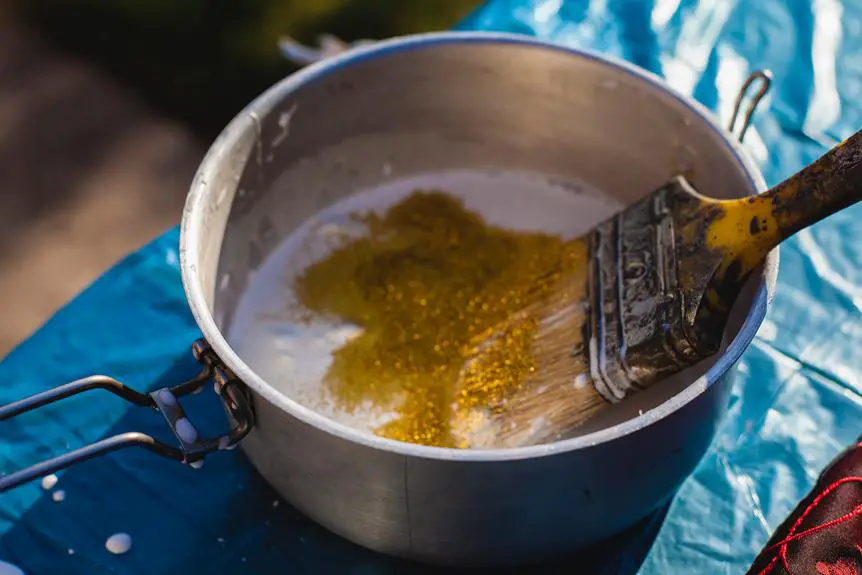Looking to master the art of removing hot glue from different fabrics? Look no further! This guide will equip you with 5 clever techniques to easily dissolve hot glue without damaging your fabrics.
From the hot water soak method to the iron and paper bag method, you'll have a range of effective strategies at your disposal.
Whether it's delicate silk or sturdy denim, these methods will help you conquer any hot glue mishap with ease and precision.
So, get ready to tackle those stubborn hot glue stains like a pro!
Key Takeaways
- Soaking hot glue in hot water for at least 15 minutes is an effective and time-saving method for removing hot glue from cotton, linen, and polyester fabrics.
- Freezing delicate fabrics with hot glue can make the glue brittle, allowing it to be easily scraped off with a blunt tool.
- Rubbing alcohol can be used to dissolve hot glue, minimizing the risk of damage to delicate fabrics.
- Using an iron and a paper bag can help remove hot glue from fabrics by running a warm iron over the paper bag in a circular motion.
Hot Water Soak Method
Start by soaking the hot glue in hot water for at least 15 minutes to loosen its grip on the fabric fibers. This method is particularly effective for fabrics that are compatible with water, such as cotton, linen, and polyester. It's a time-saving technique because it allows you to work on other tasks while the hot water does the job of softening the glue.
Before you begin, ensure that the fabric can withstand water without damage, as some delicate fabrics may not be suitable for this method. Once the hot glue has had time to soak, gently peel it off the fabric. If the glue doesn't come off easily, continue soaking and periodically check until it loosens sufficiently.
This technique not only saves time but also minimizes the risk of damaging the fabric compared to more aggressive removal methods. By leveraging fabric compatibility and time-saving techniques like the hot water soak method, you can effectively dissolve hot glue without compromising the integrity of the fabric.
Mastering this approach will equip you with a valuable skill for handling hot glue mishaps on various fabrics.
Freezing Technique
When should you use the freezing technique to dissolve hot glue on fabrics?
The freezing technique is best used when dealing with delicate fabrics that can't withstand the hot water soak method. By subjecting the hot glue to extreme cold, a chemical reaction occurs, causing the glue to become brittle and easier to remove without damaging the fabric.
Here's how to use the freezing technique effectively:
- Place the fabric in a sealable plastic bag.
- Place the bag in the freezer for 1-2 hours, depending on the size of the glue stain.
- Remove the fabric from the freezer and quickly scrape off the brittle hot glue using a blunt tool.
- If the glue doesn't come off easily, repeat the process until the glue is completely removed.
- Finally, launder or dry clean the fabric as recommended.
The freezing technique relies on thermal shock, which weakens the adhesive properties of the hot glue, making it simpler to eliminate. This method is particularly useful for fabrics like silk, satin, and lace, where traditional methods could cause damage.
Rubbing Alcohol Solution
To further address the removal of hot glue from fabrics, you can effectively use a rubbing alcohol solution to dissolve the adhesive. This DIY fabric-safe method provides a quick and effective removal solution for hot glue mishaps.
First, dampen a clean cloth with rubbing alcohol. Gently dab the affected area, allowing the alcohol to penetrate the glue. As the alcohol seeps into the adhesive, it weakens the bond, making it easier to remove.
Continue to dab and apply the rubbing alcohol until the glue begins to loosen. Then, carefully peel or scrape off the softened glue using a plastic scraper or your fingertips. This method is particularly useful for delicate fabrics as it minimizes the risk of damage.
Using rubbing alcohol as a solvent for hot glue provides an alcohol-free alternative to harsh chemical solvents. It's a versatile and readily available solution that can effectively dissolve hot glue without causing harm to most fabrics. This technique is suitable for those seeking a gentle yet efficient approach to removing hot glue from various materials.
Vinegar and Dish Soap Treatment
For a gentle yet effective method to dissolve hot glue on different fabrics, mix one tablespoon of vinegar with a few drops of dish soap to create a fabric-safe solution.
To effectively use the vinegar and dish soap treatment, follow these steps:
- Fabric Compatibility: This method is safe for most fabrics, but it's always best to spot-test on a small, inconspicuous area first to ensure compatibility.
- Application Process: Apply the vinegar and dish soap solution directly onto the hot glue stain and let it sit for a few minutes to penetrate the glue. Gently rub the area with a soft-bristled brush or cloth to help loosen the glue.
- Rinse: Thoroughly rinse the treated area with lukewarm water to remove the dissolved glue and any residual solution.
- Blot and Air Dry: Pat the fabric dry with a clean cloth and allow it to air dry completely before assessing the results.
- Repeat if Necessary: For stubborn glue stains, you may need to repeat the process until the glue is completely dissolved.
This fabric-friendly method offers a safe and practical approach to removing hot glue from a variety of fabrics.
Iron and Paper Bag Method
You can use an iron and a paper bag to effectively remove hot glue from different fabrics. This method is based on the principle of heat transfer to soften and lift the adhesive from the fabric.
Start by heating the iron to a low setting without steam. Place the fabric with the hot glue stain facing up on an ironing board. Then, place a plain paper bag over the affected area.
Gently run the warm iron over the paper bag in a circular motion for about 10-15 seconds. Check the paper bag for any transferred glue residue. If the glue has transferred onto the paper bag, replace it with a new one and continue the process until there's no more glue residue on the paper bag.
The heat from the iron helps to soften the hot glue, allowing it to adhere to the paper bag through the heat transfer process. The paper bag acts as a barrier that absorbs the softened glue, effectively aiding in adhesive removal from the fabric.
This method is particularly useful for delicate fabrics as it provides a controlled and gentle approach to removing hot glue.
Frequently Asked Questions
Can Hot Glue Be Dissolved Using Any Natural Ingredients or Household Items Other Than the Ones Mentioned in the Article?
Yes, natural ingredients like vinegar and lemon juice can dissolve hot glue. Household items such as rubbing alcohol and baking soda are also effective. Impact on fabric varies, but freezing for 15-30 minutes can aid removal.
Are There Any Risks or Potential Damage to the Fabric When Using the Hot Water Soak Method?
When soaking fabric in hot water to dissolve hot glue, there are potential risks of damaging delicate fabrics. Using alternative ingredients or household items, such as rubbing alcohol or acetone, may be gentler options.
How Long Should the Fabric Be Left in the Freezer When Using the Freezing Technique?
For most fabrics, leave them in the freezer for at least 1-2 hours. Delicate fabrics may need less time. If the freezing technique doesn't work, try rubbing alcohol or vinegar to dissolve hot glue.
Is There a Specific Type of Rubbing Alcohol That Works Best for Dissolving Hot Glue on Fabrics?
For dissolving hot glue on fabrics, use 90% isopropyl rubbing alcohol. It's effective on various fabrics. Natural alternatives like vinegar can also work. Be cautious with heat-sensitive fabrics and freezing, as it may damage delicate materials.
Can the Iron and Paper Bag Method Be Used on Delicate or Heat-Sensitive Fabrics?
Yes, the iron and paper bag method can be used on delicate or heat-sensitive fabrics, but with caution. Solvent alternatives like acetone or nail polish remover may also work, but test first.
- Does Chiffon Fabric Stink - July 15, 2025
- Does Chiffon Fabric Affect the Economy - July 15, 2025
- Does Cotton Fabric Have a Nap - July 15, 2025





